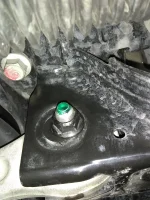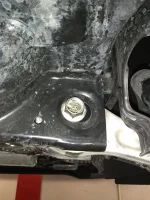inmanlanier
Getting familiar with the group...
- Joined
- Jun 9, 2011
- Messages
- 200
- Reaction score
- 54
- Points
- 28
- Location
- Palm Beach Gardens, FL
- Genesis Model Type
- 2G Genesis Sedan (2015-2016)
Up in North Carolina. The car drove great. Data below is with me as a passenger in the car on the alignment rack. With me getting out of the car, the front camber became more positive by about 0.2 to 0.3 degrees up front, so with my wife driving the car should be around -.5 / -.5 front camber.
ALIGNMENT NUMBERS:
FRONT
camber (L/R) as-found: -.9/-1.0 degrees. As-left: -0.6/-06. degrees
caster (L/R) as-found: 8.9/8.9 degrees As-left - 7.4 / 8.4 degrees (note 1 degree bias less on left side)
REAR:
camber (L/R) as-found -2.4 degrees/-2.1 degrees. (WAY TOO MUCH IHMO) As left - 1.3/-1.2. I like less, but that's as far as I could adjust.
the front camber was out of spec as delivered. Amazing they don't allow for any adjustments other than toe.
We noted the caster up front was the same side to side before alignment, so with amount the car was pulling to the right we guesstimated around a 0.8 degree bias should work. I was happy with a 1 degree bias not to tweak any more. It worked out fine. On a left crown, the car pulls left. On a moderate crown right (most roads I drive) - the car tracks nice and strait.
We ended up slotting both the lower control arm frame holes (each side) and the tension arm frame holes (each side). We hoped only to do the left side tension arm holes, but had to do the right as well. With my carbide holes, they slotted relatively quickly. The recessed boss around the hole for the nut/bolt head is plenty round so that after adjustments the bolt heads and nuts were not cocked. In general we slotted 1/4" to 3/8" each hole (on the lowers, we slotted inboard so that we could reduce negative camber). On the tension holes, I think we went opposite directions to get the desired caster changes. The car is now fully adjustable. I've attached a sample photo so you can see what was done.
Good job Marcello at Ernie Bello Motorsports in West Palm Beach!
ALIGNMENT NUMBERS:
FRONT
camber (L/R) as-found: -.9/-1.0 degrees. As-left: -0.6/-06. degrees
caster (L/R) as-found: 8.9/8.9 degrees As-left - 7.4 / 8.4 degrees (note 1 degree bias less on left side)
REAR:
camber (L/R) as-found -2.4 degrees/-2.1 degrees. (WAY TOO MUCH IHMO) As left - 1.3/-1.2. I like less, but that's as far as I could adjust.
the front camber was out of spec as delivered. Amazing they don't allow for any adjustments other than toe.
We noted the caster up front was the same side to side before alignment, so with amount the car was pulling to the right we guesstimated around a 0.8 degree bias should work. I was happy with a 1 degree bias not to tweak any more. It worked out fine. On a left crown, the car pulls left. On a moderate crown right (most roads I drive) - the car tracks nice and strait.
We ended up slotting both the lower control arm frame holes (each side) and the tension arm frame holes (each side). We hoped only to do the left side tension arm holes, but had to do the right as well. With my carbide holes, they slotted relatively quickly. The recessed boss around the hole for the nut/bolt head is plenty round so that after adjustments the bolt heads and nuts were not cocked. In general we slotted 1/4" to 3/8" each hole (on the lowers, we slotted inboard so that we could reduce negative camber). On the tension holes, I think we went opposite directions to get the desired caster changes. The car is now fully adjustable. I've attached a sample photo so you can see what was done.
Good job Marcello at Ernie Bello Motorsports in West Palm Beach!
Attachments
Last edited:











